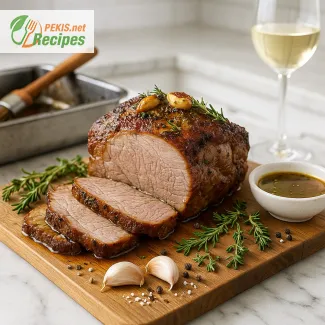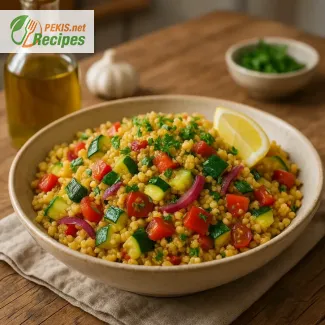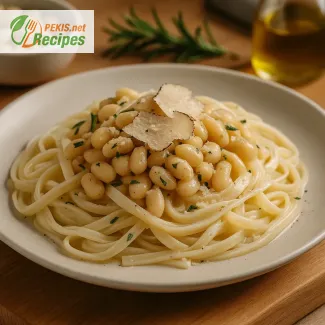Ready in 140 minutes and perfect for 4 servings, this oven-baked pork neck roast with garlic and herbs delivers a juicy, tender texture and an irresistible aroma of rosemary, thyme, and roasted garlic. Slow-cooked in white wine and chicken stock, it forms a natural, silky sauce that enhances every slice. The marbled pork neck stays moist throughout, developing a golden crust while keeping its buttery core. Ideal for family dinners or festive gatherings, it can be marinated ahead and stores beautifully for flavorful leftovers.
Years of working with different cuts of meat have taught the importance of balance—patience, proper seasoning, and the right temperature. Pork neck has always been a favorite because it rewards slow cooking with incredible tenderness and depth of flavor. Each layer of fat melts slowly, coating the meat and herbs in richness that feels almost nostalgic. There’s something grounding about the scent of garlic and rosemary filling the kitchen—simple ingredients coming together to create something truly memorable.
PEKIS – professional chef and recipe developer with over 25 years of experience in cooking and baking, specializing in European and international cuisine.

Slow-Roasted Pork Neck in the Oven with Garlic and Fresh Herbs
A fragrant, melt-in-your-mouth pork roast that celebrates rustic comfort and timeless flavor
When pork neck meets slow oven roasting, something magical happens. The marbled layers of meat gently baste themselves as they cook, creating a juicy, tender texture that rivals any restaurant-quality roast. The aroma of roasted garlic, fresh rosemary, and thyme fills the kitchen, signaling the kind of meal that invites everyone to gather around the table. It’s not just about meat—it’s about warmth, patience, and a flavor that deepens with every minute in the oven.
Unlike leaner cuts, pork neck is naturally rich in intramuscular fat, which ensures a luscious, moist interior. When roasted slowly, it transforms into a dish with crispy golden edges, caramelized juices, and a buttery-soft core. The combination of olive oil, garlic, and herbs infuses every bite with Mediterranean soul, while a touch of smoked paprika or mustard glaze can add a personal twist that elevates its rustic charm.
Origins and culinary heritage
The pork neck roast has deep roots in European home cooking, especially in Central and Eastern Europe, where it’s known as a staple for Sunday lunches and festive gatherings. Its popularity spread across regions due to the cut’s affordability, versatility, and its ability to shine even with minimal ingredients. In Italy, it’s slow-cooked with wine and herbs; in Germany, it’s often marinated in mustard and beer; while in the Balkans, it’s grilled or roasted with garlic and paprika. The oven-baked version combines the best of these traditions—a method that brings out the authentic depth of flavor and the comfort of home-cooked meals.
The secret to perfectly tender pork neck
The key lies in low and slow cooking. By roasting at a moderate temperature, the connective tissue gradually melts, enriching the meat with succulence and creating a silky, melt-in-the-mouth texture. A brief sear before baking can enhance the Maillard reaction, forming that irresistible crust that locks in flavor. Resting the meat after baking allows the juices to redistribute, ensuring every slice stays moist and flavorful.
To enhance the aroma, rub the roast generously with crushed garlic, sea salt, freshly cracked pepper, and rosemary sprigs. Adding a splash of white wine or chicken stock to the roasting pan keeps the environment humid, preventing the roast from drying out and producing a natural gravy that coats each piece.
Why you’ll love this recipe
- Effortless preparation – minimal ingredients, maximum flavor.
- Rich and juicy texture – thanks to the perfect balance of fat and lean meat.
- Versatile seasoning – adaptable to Mediterranean, German, or Slavic styles.
- Elegant yet rustic – perfect for family dinners or festive occasions.
- Naturally aromatic – herbs and garlic transform it into a fragrant centerpiece.
Flavor dynamics and key ingredient harmony
- Garlic adds a sharp sweetness that mellows as it roasts, turning creamy and nutty.
- Herbs like thyme, rosemary, and oregano contribute an earthy freshness.
- Olive oil enhances browning and gives the crust a golden sheen.
- Salt and pepper balance the richness of the meat, intensifying natural umami.
- White wine or stock helps deglaze the pan and forms a silky jus that ties everything together.
The result is a multi-layered flavor profile: a balance of savory, herbal, and subtly sweet notes wrapped around a perfectly tender core. The dish appeals to the senses on multiple levels—visual (golden crust), olfactory (herbal aroma), and textural (juicy tenderness).
Creative variations
- Mediterranean style: add lemon zest, capers, and a hint of oregano for a coastal touch.
- German-inspired: use mustard, caraway seeds, and dark beer in the marinade.
- Asian fusion: glaze with soy sauce, honey, and garlic for a sweet-savory contrast.
- Smoky BBQ twist: coat with paprika and liquid smoke for a backyard flavor profile.
Each variation builds on the same foundation—a robust cut that can absorb and harmonize complex flavors without losing its identity.
Storage and make-ahead preparation
Cooked pork neck stores exceptionally well. Once cooled, wrap it tightly in foil or an airtight container and refrigerate for up to three days. The flavors deepen overnight, making leftovers ideal for sandwiches, wraps, or salads. For longer storage, slice and freeze in portions; reheat gently in the oven or pan with a splash of broth to restore its juiciness.
Marinating the meat a day ahead allows the garlic and herbs to penetrate deeper, intensifying the flavor. It’s a great strategy for busy days—just roast it when you’re ready, and the hard work is already done.
Pork neck roast, garlic, herbs, and slow cooking
The pork neck roast sits at the intersection of comfort food and culinary tradition, embodying both homestyle simplicity and chef-level technique. Its balance of fat and flavor makes it a standout choice among roasting cuts, while the herbal infusion elevates its taste to something deeply aromatic and soulful. The dish bridges heritage cooking and modern minimalism, reminding us that the most memorable meals often come from the simplest ingredients treated with care.
- Prepare the meat: Pat the pork neck dry with a paper towel. Trim off any excess fat, but leave a thin layer for flavor and moisture.
- Make the marinade: In a small bowl, mix olive oil, minced garlic, rosemary, thyme, mustard, smoked paprika, lemon zest, salt, and pepper until well combined.
- Marinate: Rub the marinade evenly over the pork neck. Let it rest for at least 1 hour at room temperature or overnight in the refrigerator for deeper flavor.
- Preheat the oven: Set the oven to 170°C (340°F). Place the marinated pork neck in a roasting pan.
- Sear and roast: Roast uncovered for 20 minutes until lightly browned, then pour in white wine and chicken stock. Cover with foil and continue roasting for 90 minutes.
- Finish roasting: Remove the foil, baste the roast with the pan juices, and bake for another 10 minutes to achieve a golden crust.
- Rest and serve: Remove from the oven, cover loosely with foil, and let it rest for 10–15 minutes before slicing. Garnish with chopped parsley and serve with the pan sauce.
FAQ questionWhat oven temperature and internal temp work best for pork neck roast?
For even rendering and tenderness, roast at 170°C (340°F) until the thickest part reaches an internal temperature of 68–70°C (155–158°F), then rest 15 minutes to carryover to 72°C (162°F). This range keeps the meat juicy and tender while fully cooked. If you prefer pull-apart texture, cook covered and low until 88–92°C (190–198°F), then uncover briefly to crisp the exterior.
FAQ questionShould I sear before baking or just roast?
A quick pan sear (2–3 minutes per side) jump-starts the Maillard reaction, giving a deeper crust and richer flavor. If skipping the skillet, begin the roast uncovered for 15–20 minutes at 200°C (392°F) to brown, then drop to 170°C (340°F) and cover. Either method builds a savory crust while keeping the center moist.
FAQ questionWhat marinade or rub brings out the best flavor?
Use a balanced rub: olive oil, garlic, rosemary, thyme, sea salt, black pepper, plus a touch of Dijon mustard and smoked paprika. The oil carries fat-soluble aromas; salt penetrates for seasoned-to-the-core flavor; herbs and mustard add aromatic complexity. Marinate overnight for deeper infusion, or at least 1 hour if short on time.
FAQ questionHow do I keep the roast from drying out?
Create a humid roasting environment: add white wine and chicken stock to the pan, tent with foil after initial browning, and baste every 30–40 minutes. Choose a marbled cut (visible intramuscular fat), avoid overcooking past your target temp, and rest the meat so juices redistribute, keeping slices succulent.
FAQ questionCan I make it ahead and how should I reheat?
Yes. Chill whole or sliced, tightly wrapped, for up to 3 days. Reheat covered at 150°C (302°F) with a splash of stock until warmed through; finish uncovered for a few minutes to refresh the crust. Sliced leftovers are excellent in sandwiches, wraps, grain bowls, or diced into pan sauces for quick meals.
FAQ questionWhat are the best substitutions if I don’t have certain ingredients?
Swap chicken stock with vegetable stock; replace white wine with apple juice plus 1 tsp vinegar for acidity; use dried herbs at one-third the amount of fresh; switch butter to olive oil for dairy-free; and if Dijon is unavailable, mix mild mustard with a pinch of honey for similar tangy-smooth balance.
The oven-baked pork neck roast with garlic and herbs captures everything comforting about slow cooking—depth of flavor, succulent texture, and a rich, aromatic crust that forms naturally through time and care. Each step, from marinating to roasting, builds layers of taste that turn a simple cut of meat into a centerpiece worthy of any occasion.
What makes this dish so satisfying is its balance: the herbal freshness of rosemary and thyme, the sweetness of roasted garlic, and the subtle tang of white wine merging into a sauce that feels rustic yet refined. It’s the kind of meal that celebrates simplicity without compromising elegance, bringing familiar comfort to modern kitchens.
The texture tells the story—crispy edges yielding to a buttery interior, perfectly seasoned and moist from its own slow-rendered juices. Every bite reveals a harmony between fat, seasoning, and natural umami, the kind that lingers long after the meal.
Beyond the main course, this roast transforms effortlessly into next-day favorites—thinly sliced for sandwiches, served cold in salads, or gently reheated in its pan juices. Its versatility and staying power make it more than a single meal; it’s an experience that continues to give.
The heart of the recipe lies in patience and precision. Letting the flavors unfold slowly ensures that every aroma, every texture, and every note of garlic and herbs reaches its full expression—turning everyday ingredients into something truly memorable.
Allergens present in the recipe
- Milk – present in butter.
- Mustard – contained in Dijon mustard.
Gluten-free: Yes, naturally gluten-free.
Allergen substitution tips
- Replace butter with olive oil for a dairy-free version.
- Omit Dijon mustard or replace it with a gluten-free mustard substitute for sensitivity.
- Vitamin B1 (Thiamine) – 0.8 mg – supports energy metabolism and nerve function.
- Vitamin B6 – 0.7 mg – essential for protein metabolism.
- Vitamin B12 – 1.3 µg – contributes to red blood cell formation.
- Zinc – 4.2 mg – strengthens immune function.
- Iron – 2.1 mg – supports oxygen transport in the blood.
- Phosphorus – 260 mg – aids in bone and teeth health.
- Selenium – 32 µg – contributes to antioxidant protection.
- Beta-carotene – 0.2 mg – supports skin and eye health.
- Vitamin E – 2.4 mg – protects cells from oxidative stress.
- Polyphenols (from herbs) – 18 mg – promote heart health and reduce inflammation.





